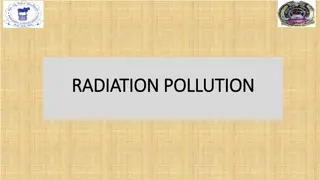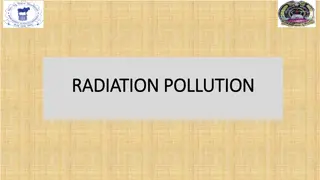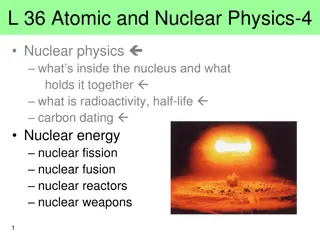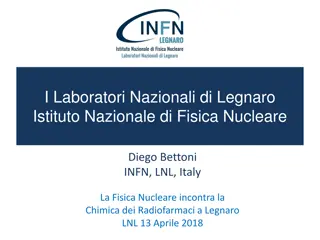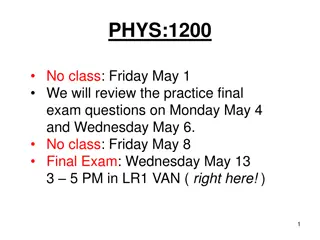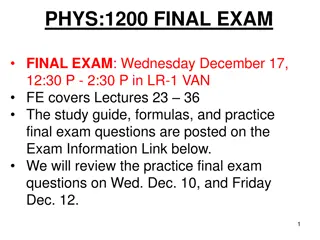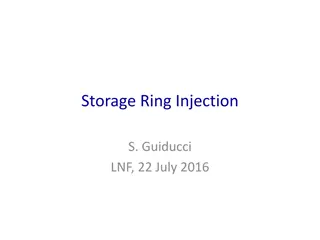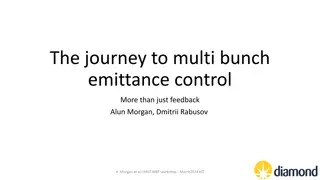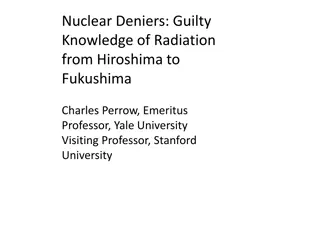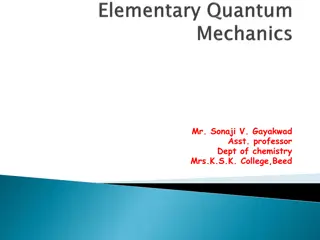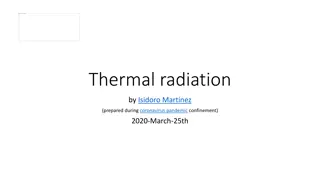Nuclear Data Needs for Radiation Detectors and Accelerators
Explore the essential nuclear data needs for developing and interpreting radiation detectors and accelerators. This session focuses on traditional and novel detector technologies, including transport modeling, stopping powers, light yields, and X-ray emission. Meet the experts from top institutions sharing insights on atomic data evaluations and their applications in basic science and beyond.
Download Presentation

Please find below an Image/Link to download the presentation.
The content on the website is provided AS IS for your information and personal use only. It may not be sold, licensed, or shared on other websites without obtaining consent from the author. Download presentation by click this link. If you encounter any issues during the download, it is possible that the publisher has removed the file from their server.
E N D
Presentation Transcript
Detector Models, Atomic Data, and Stopping Powers Brian Quiter (LBNL) Bethany Goldblum (LBNL/UC Berkeley) Bruce Pierson (PNNL) Office of Science Nuclear Science
Why are we all here? Attendees of WANDA 2019 expressed strong interest in atomic data evaluations This session focuses on nuclear data needs related to the design, development, and interpretation of data from traditional and novel radiation detectors and accelerators for basic science and applications. This includes atomic, nuclear, and optical data for transport modeling, stopping powers, Cerenkov and scintillator light yields, and X-ray emission for detection and crosscutting application needs. Office of Science Nuclear Science 2
Why are we all here? Attendees of WANDA 2019 expressed strong interest in atomic data evaluations This session focuses on nuclear data needs related to the design, development, and interpretation of data from traditional and novel radiation detectors and accelerators for basic science and applications. This includes atomic, nuclear, and optical data for transport modeling, stopping powers, Cerenkov and scintillator light yields, and X-ray emission for detection and crosscutting application needs. Data needs for Detector and Signal Modeling Office of Science Nuclear Science 3
Who Are We? Brian Quiter LBNL Staff Scientist/Engineer, Applied Nuclear Physics Program Advanced detectors, modeling detectors and detector systems, nuclear nonproliferation, NRF Bethany Goldblum UC Berkeley Research Engineer, Department of Nuclear Engineering Executive Director of NA-22 Nuclear Science and Security Consortium Organic scintillators, nuclear reactions & structure physics, nuclear physics applications Bruce Pierson PNNL Staff Scientist/Engineer, Irradiated Materials Detector development & modeling, fission yield studies, nuclear forensics, data science, radiolysis Office of Science Nuclear Science
Broad Data Needs e.g. Elpasolite scintillators Nuclear data is important for modeling and quantifying neutron detectors Fission chambers Scintillators Neutron thermalization Cascades and angular correlations Cs26LiLa(Br,Cl)6:Ce (CLLBC) 35Cl (n,p) Office of Science Nuclear Science 5
Broad Data Needs Nuclear data is important for modeling and quantifying neutron detectors Fission chambers Scintillators Neutron thermalization Cascades and angular correlations Office of Science Nuclear Science 6
Broad Data Needs Nuclear data Atomic/EM data Modeling and understanding -ray detectors Compton kinematics/electron tracking Atomic X-ray production Bremsstrahlung Attenuation data (heavy ions, electrons, photons) Understanding accelerator-induced reactions Photon detection efficiency Shielding calculations (space and terrestrial) Office of Science Nuclear Science 7
Broad Data Needs Nuclear data Atomic/EM data Attenuation data Optical Data Scintillation light transport Cherenkov phenomenology Engineering databases Detector tabulations? Build-up factors for physics experiments and/or applications? Office of Science Nuclear Science 8
Session Scope Data! Adding physics models to codes is outside WANDA scope Data needs for understanding detectors and signals for basic science and applications Signals include measurements of attenuation (densitometry etc.) Goal is to close this session with: prioritized list of needs actionable tasks to address those needs Office of Science Nuclear Science
Our Questions What are the needs? How do they map to applications? What would the impact be? What fidelity is needed? How do we address the needs? (actionable tasks) Data collection campaign/one-off, data evaluation, new database, sensitivity study, scoping study? How do we prioritize the needs? Potential impact / application space i.e. might be important to one sponsor but not another Fidelity vs. impact vs. difficulty Are there hurdles to actionable tasks? What? Level of difficulty? Office of Science Nuclear Science
Your Mission Highlight needs Have we omitted relevant applications? Map to applications Assess impact Fidelity vs. impact vs. difficulty Actionable recommendations Applications we didn t highlight Light sources (SURF, NSLS, ALS ) Medicine Detector development for TOF-PET Help us out: Provide feedback Help our rapporteur Google docs link Office of Science Nuclear Science
Outcomes Report Overview Summarize session, explain logic and methods Prioritized Needs Need 1 Need 2 actionable means of addressing those needs Office of Science Nuclear Science
Logistics Agenda 1315 Introduction Quiter, Goldblum, Pierson Programmatic Needs 1330 NNSA NA-22 Donny Hornback DTRA Joanna Ingraham Note-taking Eric Matthews (Rapporteur) efmatthews@berkeley.edu Feel free to contribute DHS Namdoo Moon User Briefs 1400 Fission Product Stopping Power Michael Moore 1410 Stopping Power for Isotope Production Cross Sections 1420 CGM Modeling in MCNP 1430 X-Ray Emission and stopping power 1445 Gamma Cascade Summing 1455 Detector Modeling for Associated Particle Imaging 1505 Antineutrino Signal Modeling for Detection 1515 Cerenkov and WbLS 1525 Fast Neutron Detector Modeling 1535 Photoatomic data Morgan Fox Michael Rising Ram Venkataramar Bruce Pierson Seth McConchie Bryce Littlejohn Chris Grant Juan Manfredi Brian Quiter 1545 Break 1605 Discussion 1715 Adjourn Office of Science Nuclear Science













